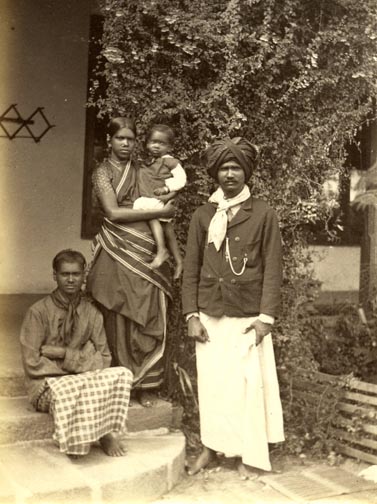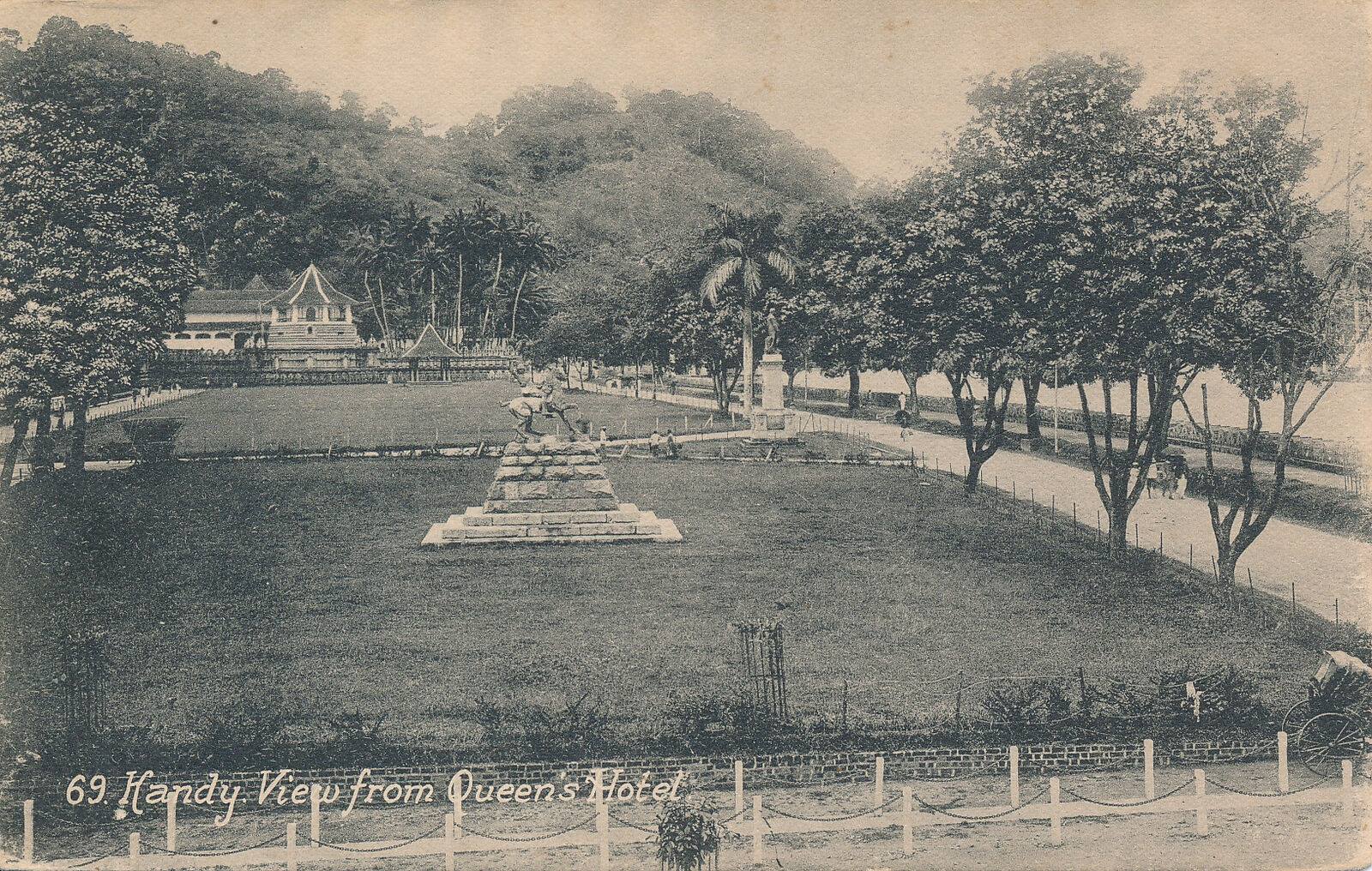The Tea-Factory
වාණිජවාදයට පුළුවන් එය ලගින ඕනම ප්රදේශයක තියන සොබා සුන්දරත්වය කොහොම හරි ක්රමේකට සම්පූර්ණයෙන්ම විනාශ කරලා දාන්න. මෙහි කඳුබඩ පළාත් මුළුමනින්ම ඉරා දමලා. අතිවිශාල රූබර වනපෙත් කඳු පාදමේ ඉඳන් මුදුනටම කපා දාලා.
 |
| Portmore Bungalow, Lindoola photographed by Scowen & Co. [Image Courtesy: http://www.imagesofceylon.com ] |
තේ ඉස්ටෝරුව
 |
| Clearing Land for a Tea Estate photographed by Plate & Co. [Image Courtesy: http://www.imagesofceylon.com ] |
 |
| Group of Estate Workers - In Background Deforestation photographed by Skeen & Co. [Image Courtesy: www.imagesofceylon.com ] |
මේ නිෂ්පාදන කෙළින්ම නවත්තලා දැම්මොත් කොච්චර යහපතක්ද වෙයිද! ඒ වුණත් එක එක රටවල් වල වාණිජ ප්රතිපත්ති, මේ වගේ දේවල් වලට මිනිස් හිත් පොළඹවන ගමන් හැමතිස්සේම ජීවිතයේ අත්යාවශ්ය කාරණා නොසලකා හරවන්න කටයුතු කරනවා. ඔවුන් ඒ සඳහා උත්තේජක උත්තේජනය කරනවා. අපි ඕනාවට වඩා මේ ගැන විවේචනාත්මකව දකින්න උවමනා නැහැ. ඒත් මේ වගේ අතිවිශාල කැප කිරීමකින් වැඩ කරන්න තරම් නූතන රටවල් මෙච්චර වද වෙන්නේ මොකද කියන එකේනම් යම් අමුත්තක් තියනවා.
 |
| Tea Factory, Poonagala, Haputale photographed by Scowen & Co, [Image Courtesy: www.imagesofceylon.com ] |
හැම තේ වත්තකම කුලීකරුවන් ජීවත් වෙන ලයින් කාමර පේළි දකින්න පුළුවන්. තේ ඉස්ටෝරුව විශාල දැවයෙන් සකසපු ගොඩනැගිල්ලක්. ජනේල පේළියක්, වාෂ්ප එන්ජිමක් සහ එක එක දේවල් වලට; ඒ කියන්නේ වියළන්න, තවන්න, පෙරළන්න, ගිනි අවුලවන්න, තෝරන්න, අසුරවන්න වගේ වැඩ වලට උවමනා කරන යන්ත්රෝපකරණ මෙහි තියනවා.
 |
| Equipment Inside the Tea Factory photographed by Skeen & Co. [Image Courtesy: www.imagesofceylon.com ] |
 |
| Planting Tea Bush photographed by Skeen & Co. [Image Courtesy: http://www.imagesofceylon.com ] |
කලින් වතාවේ දළු නෙලාගත්තට පස්සේ ළපටි කොළ පහ හයක් අළුතින් දළු දාපු ගමන්ම ආයෙත් කම්කරුවන් කණ්ඩායමක් එනවා දළු නෙළන්න. වැඩිපුරම මේ වැඩේට එන්නේ කාන්තාවන් සහ දැරියන්. හැම කෙනා ළඟම, නෙළා ගත් තේ දළුයි සුරුන්ඩු වුණු පත්රාංකුරයි දමන්න කූඩයක් තියනවා. මේ වැඩේ නම් අනික් හැම දේටම වඩා බොහොම වැදගත් කාර්යයක්.
 |
| Spreading the Tea Leaves photographed by Skeen & Co. [Image Courtesy: http://www.imagesofceylon.com ] |
දළු ටික තේ ඉස්ටෝරුවට ගෙනිච්චම මුලින්ම තුනියට අතුරනවා වියළන්න.
 |
| Rolling the Tea Leaves photographed by Skeen & Co. [Image Courtesy: http://www.imagesofceylon.com ] |
ඊට පස්සේ යන්ත්රසූත්ර පාවිච්චි කරලා පෙරළාගන්නවා (අංකුරයක් වගේ පේන්න).
 |
| Firing the Tea Leaves photographed by Skeen & Co. [Image Courtesy: http://www.imagesofceylon.com ] |
ඊටත් පස්සේ කෘත්රිමව වේලගන්නවා. හරියට පුළුස්සනවා වගේ.
 |
| Tea Leaves Sifting and Sorting photographed by CA & Co. [Image Courtesy: http://www.imagesofceylon.com ] |
මේකෙන් පස්සේ විශාල පෙනේරයකින් පෙරළා පත්ර තෝරා වෙන්කරගන්නවා. හොඳම තත්වය තියෙන්නේ කුඩා පත්රාංකුර වලට. ඒවට කියන්නේ 'ෆ්ලවරි පෙකොයි' කියලා*. ඊළඟ ප්රමාණය ටිකක් ළපටි දළු තියන එකක්. ඒකට කියන්නේ 'බ්රෝකන් පෙකොයි' කියලා. ගොරෝසු පත්ර තියන එක එන්නේ 'පෙකොයි සෝචොං', 'සෝචොං' වගේ නම් වලින්.
 |
| Grouping Tea Leaves photographed by Skeen & Co. [Image Courtesy: http://www.imagesofceylon.com ] |
වයින් වගේම තමයි තේ නිෂ්පාදනයේ තියන අමාරුකමුත්. ඒ කියන්නේ තේ දෙකක් ගත්තොත් ඒ දෙකේ රස දෙකක්, එක වගේ වෙන්නේ නැහැ. දළු නෙළන ආකාරය, තවන ආකාරය, පුළුස්සන ආකාරය වගේ ක්රියාවලියන් හැම එකක්ම අවසාන රසයට වෙනසක් එක් කරනවා. මේ නිසා තමන්ගේ පාරිභෝගිකයන්ට වෙනස් නොවන රසයකින් යුතු තේ සපයන බවට නම් දරාපු වෙළෙන්දෙක්, අපි කියමු ලන්ඩනයේ වෙළෙන්දෙක් කියලා; ඔහුට, මේ වගේ තේකක් හැදෙන්න කරන්න තියෙන්නේ බොහොම පහසු දෙයක්. කෙළින්ම කියනවනම් ඔහුට වෙළඳපොලින් සතු කරගත හැකි ඕනෑම තේ වර්ග කිහිපයක් මිශ්ර කරලා ඒ ඕන කරන ප්රතිඵලය ලබා ගන්න පුළුවන්. මේ වගේ කවලම් තේ වලට ඉතින් ලබාදෙන්නේ බොහෝ වෙලාවට ව්යාජ නම්.
 |
| Workers Packing Tea Chests photographed by Skeen & Co. [Image Courtesy: http://www.imagesofceylon.com ] |
කුලීකාරයින් ගැන “ඇජැක්ස්ගෙන්” ලියුම්
මම ඒ වගේම කැමතියි මෙතන අපේ මිත්රයා "ඇජැක්ස්" ඒවපු ලියුම් වල සඳහන් කතා එකක් දෙකක් උපුටා දක්වන්න. ඒවායෙන් හොඳට පැහැදිලි වෙනවා ඔහු දැන් වැඩ කරන තේ වත්තෙ ඉන්න කුලීකාරයන්ගේ තත්වය කොහොමද කියලා. ඔහු කියනවා මෙහෙම.
"ඕන කෙනෙක්ට මේ කුලීකාරයන් ගැන ඇල්මක් ඇති කරගන්න පුළුවන්. ඔවුන් හරියට ළමයි වගේ. එහෙම වුණොත් එහෙනම් ඔවුන්ට තියන හැම පුංචි දුක් ගැනවිල්ලක්ම කියන්න එන්නෙ ඔහු ගාවට. ගෙදර උන්දෑ තමන්ට උයලා දෙන්නෙ නැහැයි කියලා අවලාද නගන්නත් ඒවි මිනිස්සු. මේ වගේ පවුල් ප්රශ්න විසඳලා දෙන්න හැම වෙලාවකම වගේ පෙනී ඉන්නෙ වත්තේ සහීබ්. කුලීකාරයන් ගත කරන්නේ බොහොම කටුක ජීවිතයක්. ඒත් වහලුන්ට වඩා හොඳ සැලකීමක් ලැබෙනවා. මොකද මේ ගොල්ලෝ බොහොම කැමැත්තෙන්නෙ වැඩ කරන්නේ. හැබැයි තව දුරටත් මට කියන්න තියෙන්නේ මේගොල්ලෝ ගෙදර ඉඳන් සන්නාලියන්, වැඩපොල සේවිකාවන්, කම්කරුවන් වගේ දුගී දිවියක් ගත කරනවට වඩා නම් මෙතන හොඳයි."
 |
| Tamil Canganam and Family photographed by Scowen & Co. [Image Courtesy: www.imagesofceylon.com ] |
 |
| Workers Plucking Tea Leaves photographed by Plate & Co. [Image Courtesy: http://www.imagesofceylon.com ] |
“මම කණගාටු වුණා මේක අත හැරලා යන්න (කලින් වත්ත); ගොඩාක්. මට එහිදි වතු කුලීකරුවන් සෑහෙන පිරිසක් අඳුනගන්න ලැබුණා. අඩු ගණනේ තුන්සීයක පිරිසක්වත් මගේ යටතේ හිටියා. ඔවුනුත් මාව ගොඩක් හොඳින් අඳුනගෙන හිටියා. ඔවුන් බොහෝ දෙනෙක්ට මාත් එක්ක එන්න ඕනකම තිබ්බා. ඒත් එහෙම කරන්න අවසරයක් නැහැ. සමහරක් අය කිව්වේ ඔවුන් තමන්ගේ නම, වත්තේ කම්කරු ලයිස්තු පොතෙන් කපාගෙන මම යන ඕනම තැනකට එනවා කියලා. ඒත් ඇත්තටම ඔවුන්ට එහෙම කරන්න බැහැ. මට හිතාගන්න අමාරු වුණා ඒගොල්ලන්ට එහෙම උනන්දුවක් තදියමක් ඇතිවුණේ මොකද කියලා. මොකද මම ඔවුන් ලව්වා මම හිටපු හැම වෙලේම සෑහෙන වැඩ කරවා ගත්තා කියල මම දන්නවා. මම හිතන්නේ මට කලින් හිටපු නිලධාරියා පුරුදු වෙලා හිටියා හැම වෙලේම වගේ ඔවුන්ට දඩ ගහලා තළලා දාල වැඩ ගන්න. මොකද ඔහුට බොහෝ වෙලාවට මොවුන් කියන දෙයක් තේරුණේ නැති හන්දා. ඒ වගේම ඔවුන්ට යමක් හොඳින් තෙරුම් කරලා දෙන්නත් ඔහුට බැරි වුණා. මම කුලීකරුවන්ට හරිම කැමතියි. ඇත්තටම කෙනෙකුට ඔවුන්ට බොහොම සමීප වෙන්න පුළුවන්. පෙනෙන විදිහට ඔවුන් ජම්මයෙන්ම ආචාරසම්පන්නයි. ඔබ අසනීපයෙන්නම් ඔවුන් හරියට කාන්තාවන් වගේ. ඇත්තටම කිසිම වෙලාවක ඔබව දාලා යන්නේ නැහැ. ඒත් උසස් නම්බුකාර කුල වල ඉන්න බාබුලා නම් පිළිකුල් සහගතයි මම හිතන්නේ.”
[අනුවාදක සටහන:
*- තේ ශ්රේණිගත කල හැකි ප්රධාන ආකාර කිහිපයකි. එම වර්ග තවත් අතුරු වර්ග ගණනාවකටම බෙදී යයි.
]
“ආදම්ගේ ශිඛරය මතින් එලිෆන්ටා ගුහා වෙත – ලක්දිව සහ ඉන්දියාවේ රූප සටහන්” : එඩ්වඩ් කාපෙන්ටර්
සිව්වන පරිච්ඡේදය : සිරිපා ශිඛරය හා කළු ගඟ
From Adam’s Peak To Elephanta : Sketches in Ceylon and India by Edward Carpenter
CHAPTER IV: ADAM’S PEAK AND THE BLACK RIVER.
Commercialism somehow has a way of destroying all natural beauty in those regions where it dwells. Here the mountain sides are torn up, the immense and beautiful forests ravaged from base to summit, and the shaly escarpments that remain planted in geometrical lines with tea-shrubs. You may walk for miles through such weary lands, extending rapidly now all over the mountain region from the base to near the tops of the highest mountains, the blackened skeletons of half-burnt trees alone remaining to tell of the old forests, of which before long there will be but a memory left.
It is curious, when one comes to think of it, that such huge spaces of the earth are devastated, such vast amounts of human toil expended, in the production of two things—tea and wine—which to say the least are not necessaries, and which certainly in the quantities commonly consumed are actually baneful. If their production simply ceased, what a gain it might seem ! Yet the commercial policies of the various nations stimulate these, and always to the neglect of the necessaries of life. They stimulate the stimulants. We need not be hypercritical, but there must be something peculiar in the temper of the modern nations that they make such tremendous sacrifices in order to act in this way.
On each tea-plantation there are the "lines" (rows of huts) in which the coolies live, and the "factory"—a large wooden building, with rows of windows, a steam engine, and machinery for the various processes concerned—withering, fermenting, rolling, firing, sorting, packing, etc. The tea-bushes (a variety of the camellia) are not allowed to grow more than three or four feet high. In Ceylon the plucking goes on almost all the year round. As soon as the young shoots, with five or six leaves, have had time to form since the last plucking, a gang of workers comes round—mostly girls and women for this job—each with a basket, into which they pluck the young leaves and the little rolled- up leaf-bud, most precious of all. When taken to the factory the leaves are first spread out to wither, then rolled by machinery (to look like buds), then dried or baked by artificial heat. After this they are sorted through a huge sieve, and the finest quality, consisting of the small leaf-bud, is called Flowery Pekoe ; the next size, including some of the young leaf, is called Broken Pekoe ; and the coarser leaves come out as Pekoe Souchong, Souchong, etc. The difficulty with tea, as with wine, is that no two yields are alike ; the conditions of plucking, fermenting, firing, etc., all make a difference in the resultant flavor. Hence a dealer, say in London, who reckons to supply his customers with tea of a certain constant flavor, has simply to make such tea as best he can—namely by "blending" any teas which he can lay hold of in the market, and which will produce the desired result. The names given in these cases are of course mostly fictitious.
I may as well insert here one or two extracts from letters since received from our friend "Ajax," which will perhaps help to show the condition of the coolies In the tea-gardens where he is now working. He says :—
"One gets very fond of the coolies, they are so much like children ; they bring all their little grievances to one to settle. A man will come and complain that his wife refuses to cook his food for him ; the most minute details of family affairs are settled by the sahib of the garden. The coolies have a hard time, and are treated little better than slaves ; most willing workers they are. Still all I can say is that they have a much better time than the very poor at home, such as the factory girls, tailoresses, etc., and laborers. On this garden they have met with exceptionally hard lines ; the manager being an ill-bred man has had no consideration for his men, and they have died in hundreds from exposure to weather in the garden and houses, which had all crumbled away from neglect. Many families of ten or eleven in number have dwindled away to one or two. In one case, two little fellows of eight and nine, living together on five rupees a month, are the only representatives (of a former family)."
"I was sorry to leave (the former garden), very ; I had got to know the coolies, 300 of them at any rate who were under my charge, and they had got to know me. Many of them wanted to come with me here, but that is not allowed. Some said they would 'cut their names,' that is take their names off the garden labor-register, and go wherever I went, but of course they could not do that. I don't know why they were so anxious to come, because I know I worked them very hard all the time I was there. I think my predecessor used to fine them and thrash them a good deal, often because he did not know what they said, and could not make them understand. I like the coolies very much, and one gets quite attached to some of them ; they seem instinctively polite ; and if you are ill, they tend you just like a woman—never leave one in fact. The higher and more respectable class of Baboos are just as objectionable, I think."
ලක්දිව ගමන් සටහන් පිටු අංක: 35




Comments
Post a Comment